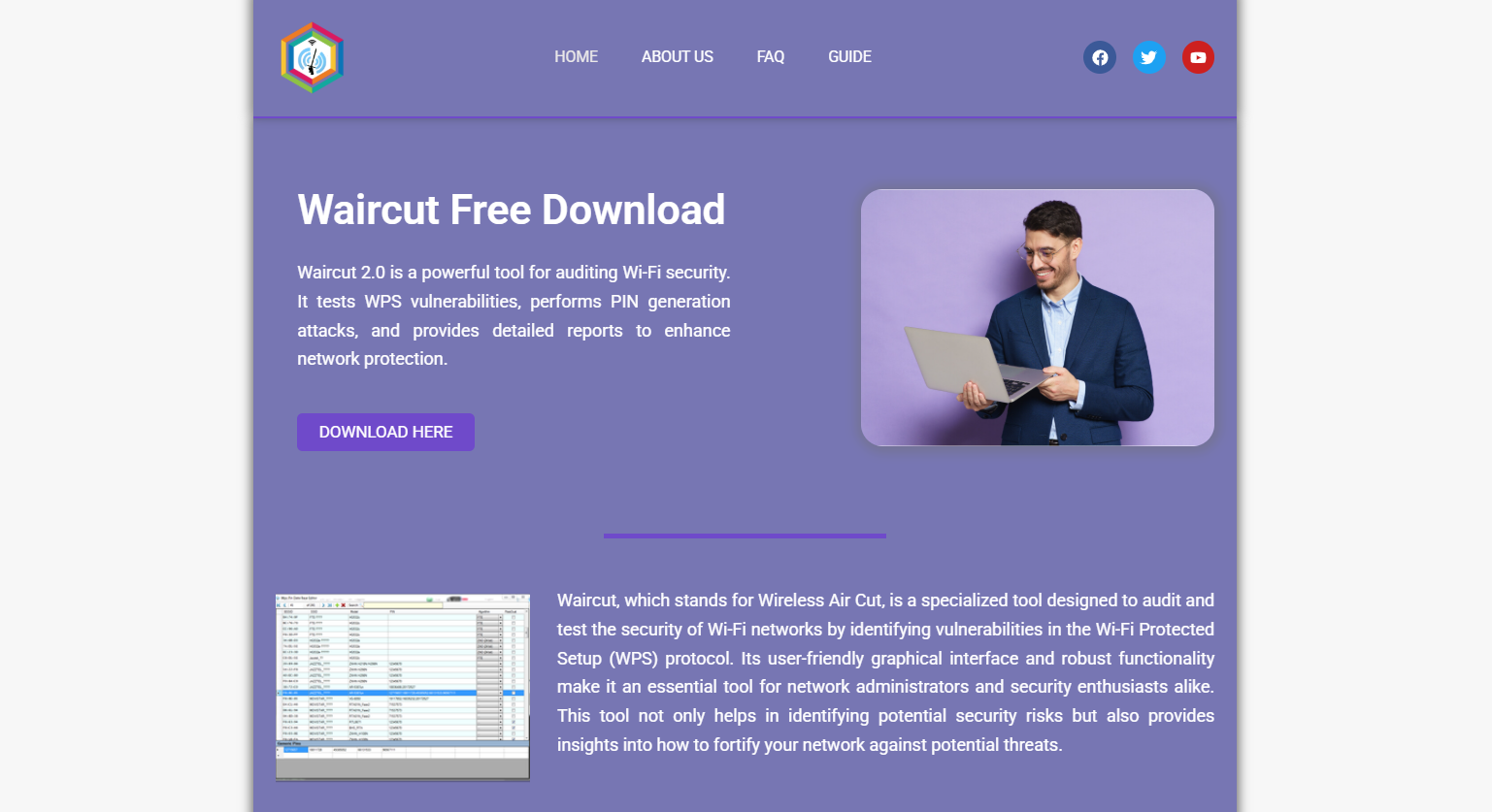Wi-Fi security isn’t something you can take lightly anymore. In today’s hyper-connected world, an unsecured network can be exploited in seconds, exposing personal data, confidential files, or even financial credentials. While complex passwords are often touted as the first line of defense, many people overlook vulnerabilities built into the network configuration itself. That’s exactly where Waircut steps in, offering a way to reveal how secure your Wi-Fi network truly is, especially when it comes to WPS (Wi-Fi Protected Setup).
Waircut is a free and open-source auditing tool for Windows, built to scan for and test vulnerabilities in wireless networks. Unlike typical penetration testing software, Waircut focuses specifically on WPS-based security flaws. These flaws often allow attackers to extract Wi-Fi passwords, even if the password itself is strong and complex.
What Waircut Actually Does
Waircut isn’t your typical Wi-Fi password cracker. It doesn’t run endless brute-force attacks or try to guess every combination of letters and numbers in your password. Instead, it targets the structural weakness of the WPS protocol—a vulnerability that allows for the retrieval of the network key without requiring a direct encryption break.
WPS was designed for convenience. With a simple PIN or push-button method, devices could be connected without entering long passwords. However, this convenience came at a cost. The WPS PIN is just eight digits long and is split during verification, making it highly susceptible to brute-force attempts. Worse, many routers still use default WPS settings or have no rate-limiting protections at all. That means even outdated or basic attacks can succeed in retrieving the PIN—and subsequently, the network password.
Waircut exploits these weak spots by simulating an attacker’s approach to WPS vulnerability checks. When successful, it can expose the actual Wi-Fi password, even if it’s long, randomized, or alphanumeric.
Analyzing Wi-Fi Network Strength with Waircut
Although Waircut doesn’t try to guess the WPA or WPA2 password through traditional methods, it reveals whether the router allows WPS exploitation. If WPS is enabled and misconfigured, anyone can retrieve the Wi-Fi key without ever touching the main password.
This means the strength of the password becomes irrelevant if the system lets someone bypass it. In this way, Waircut indirectly identifies weak Wi-Fi passwords—not because the password itself is easy, but because the process used to access it is flawed.
The tool also includes a built-in database of known WPS PINs used by router manufacturers. This allows Waircut to test routers against a collection of commonly used and default PINs. If your router is on that list, and you haven’t changed any of the settings, Waircut will likely expose the password quickly.
Beyond default configurations, Waircut examines whether the router is using a predictable key generation method, which has been an issue in older models. Some firmware versions follow algorithmic patterns that can be easily reversed if the SSID or MAC address is known.
Why Waircut Is Still Relevant in 2025
You’d think that by now, most routers would have moved on from WPS or patched its vulnerabilities. Surprisingly, many routers still ship with WPS enabled by default, often without user knowledge. Internet Service Providers rarely emphasize security when distributing preconfigured routers, and the average user doesn’t dive deep into their router settings after installation.
That’s why tools like Waircut are still relevant. It provides a visual, data-backed confirmation of whether your Wi-Fi setup is genuinely secure or just pretending to be. For cybersecurity professionals, IT students, and privacy-focused individuals, Waircut remains a lightweight but sharp weapon in the digital toolbox.
Its purpose isn’t to attack—it’s to audit. When used correctly, it gives users a chance to fix vulnerabilities before someone with malicious intent exploits them.
Technical Features That Matter
One of Waircut’s most attractive qualities is its simplicity. Unlike more complicated penetration testing tools that require deep command-line knowledge, Waircut offers a GUI interface that anyone with basic technical knowledge can navigate. You don’t need to be a cybersecurity expert to use it effectively.
It works by integrating with existing software like JumpStart, along with network capture libraries like WinPcap or Npcap. These allow Waircut to interact with Wi-Fi interfaces at a low level, enabling detailed analysis of each network’s WPS configuration.
Once launched, the tool scans for all available wireless networks within range. It identifies those with WPS enabled, lists their SSID, MAC address, channel, and signal strength. From there, it runs PIN tests using both brute-force simulation and known PIN databases.
It then returns a detailed report showing whether the WPS PIN was accepted, whether the WPA key was exposed, and what type of security weaknesses exist. In most real-world cases, this is enough to determine if the router is vulnerable to easy exploitation.
Security Implications and Ethical Use
Like any tool capable of revealing network vulnerabilities, Waircut can be abused. While the software itself is legal and open-source, using it on any network without permission is illegal in most jurisdictions. Gaining unauthorized access to a Wi-Fi network—even for testing purposes—is considered a breach of digital privacy laws and may carry criminal penalties.
The ethical use of Waircut should be limited to personal networks, educational labs, or situations where explicit permission has been granted. It can be a powerful tool for home users trying to harden their network or IT departments looking to audit company routers for overlooked risks.
When used responsibly, Waircut becomes an asset in proactive cybersecurity. It helps surface invisible weaknesses, offering clear insight into what steps must be taken to prevent unauthorized access.
Common Scenarios Where Waircut Helps
In a typical home setup, users may rely on the router provided by their ISP. These routers often come with factory settings intact, including WPS enabled. Most users are unaware of the security risks tied to WPS, and unless it’s explicitly turned off, the network remains vulnerable.
Waircut helps homeowners identify this hidden flaw quickly. It doesn’t require disassembling router settings or deciphering log files—it visually confirms whether a router is accepting weak PINs or disclosing the network key through insecure channels.
Small business environments face similar challenges. Many SMEs run their operations on consumer-grade equipment with little to no security audits. Waircut allows IT personnel to identify unsafe routers that could compromise the entire business network.
In learning environments, students studying cybersecurity or ethical hacking benefit from hands-on tools like Waircut. It bridges the gap between theory and practice, allowing them to see exactly how theoretical vulnerabilities translate into real-world risks.
Mitigating Wi-Fi Weakness After Testing
If Waircut detects a vulnerability, taking action becomes crucial. The first recommendation is to disable WPS entirely through the router’s configuration page. Most modern devices offer the option to toggle this feature off, and once disabled, the door for this kind of attack is effectively closed.
Updating the router firmware is another essential step. Many older vulnerabilities are patched in newer updates, but users often leave their firmware outdated for years. Manufacturers occasionally release updates silently, so checking manually is important.
Replacing the router altogether might be necessary in cases where firmware updates are unavailable or the WPS cannot be disabled. Older router models with known exploits should be retired in favor of newer hardware that supports WPA3 encryption and improved protection protocols.
Changing your Wi-Fi password and router admin credentials is also advised. Even if Waircut doesn’t reveal any vulnerability, using default login credentials is a common and dangerous oversight.
Waircut’s Strengths and Weaknesses
One of Waircut’s biggest strengths is its specialization. Unlike bloated network testing suites, it focuses purely on WPS vulnerability—doing one thing and doing it well. Its open-source nature allows anyone to inspect the code, contribute improvements, or adapt it to their own testing environments.
It’s also very lightweight and doesn’t consume much system memory or processor power. The UI is intuitive, and it works seamlessly with Wi-Fi adapters that support monitor mode.
On the downside, Waircut only works on Windows platforms. It also relies heavily on external tools like JumpStart, and some users might find setting up dependencies a bit cumbersome. Another limitation is that Waircut is ineffective on routers that have WPS disabled, though in that case, the network is considered secure from this particular angle.
Waircut doesn’t test WPA keys directly or perform dictionary-based password attacks. For users expecting a full hacking suite, this can be disappointing, but that’s also what keeps it focused and legally safer to use within ethical boundaries.
Conclusion
Waircut offers a unique look into a critical but often ignored aspect of wireless security. It shows that even the strongest Wi-Fi passwords are meaningless if the router itself is vulnerable. Through WPS-based testing, Waircut allows users to identify hidden doors that attackers might use to slip into their network, no matter how strong their password appears to be.
Rather than breaking encryption head-on, Waircut finds the structural flaws that let others walk in through the side gate. This approach makes it incredibly valuable as a network auditing tool. When used correctly, Waircut doesn’t just expose weaknesses—it empowers users to fix them before they’re exploited.





